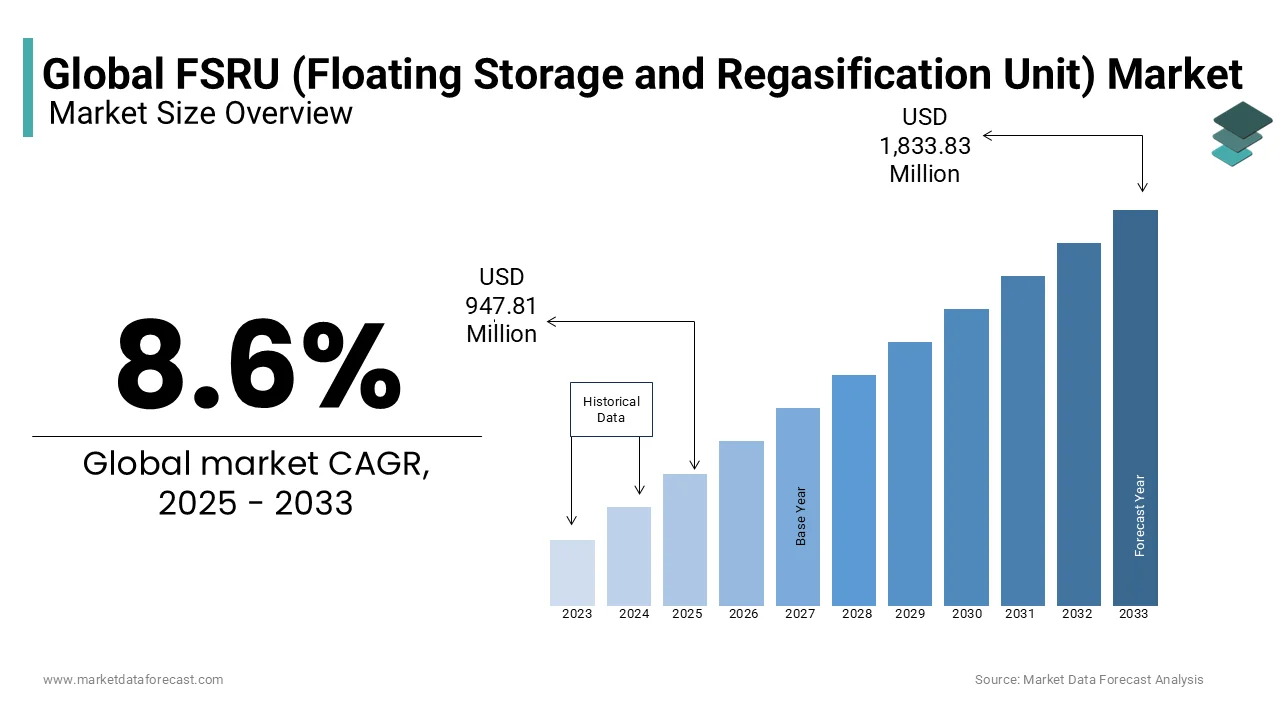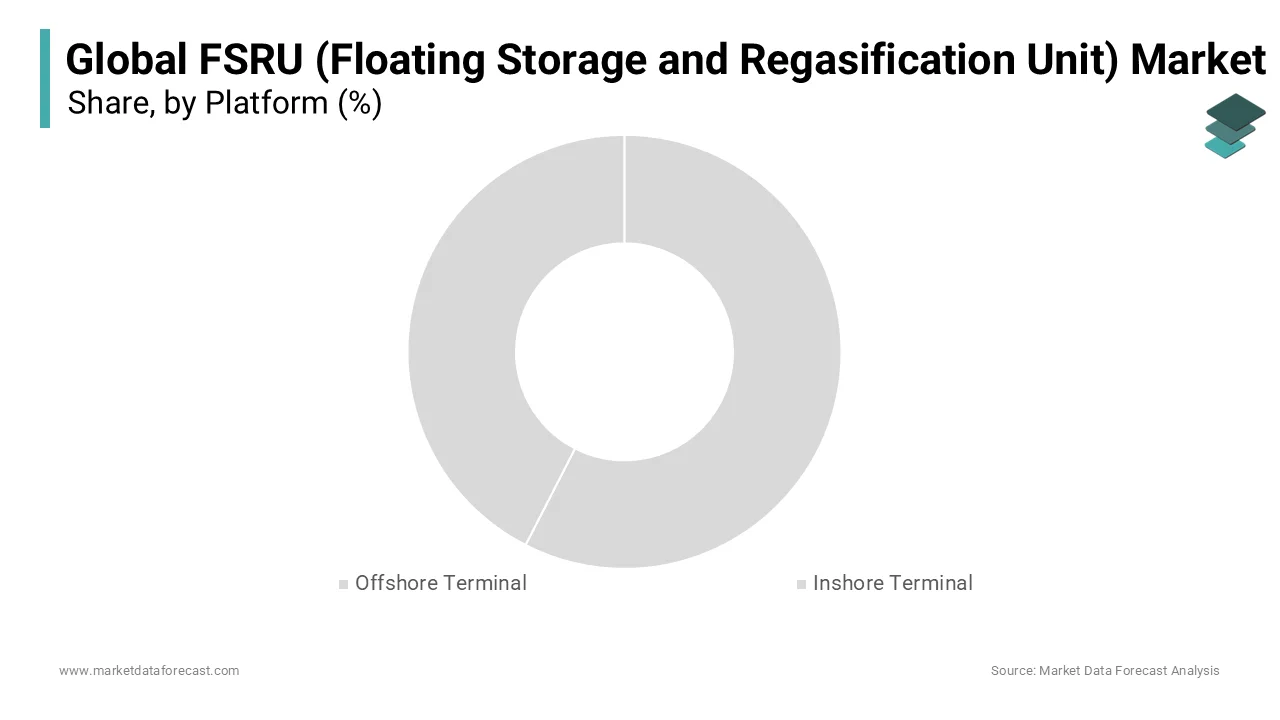Global FSRU (Floating Storage and Regasification Unit) Market Size, Share, Trends and Growth Analysis Report By Platform (Offshore Terminal, Inshore Terminal), By Design (Barge-based, Carrier Vessel-Based Segments), and Region, Industry Forecast, 2024 to 2033
Global FSRU (Floating Storage and Regasification Unit) Market Size
The size of the global FSRU (floating storage and regasification unit) market was worth USD 872.75 million in 2024. The global market is anticipated to grow at a CAGR of 8.6% from 2025 to 2033 and be worth USD 1,833.83 million by 2033 from USD 947.81 million in 2025.

The expansion of natural gas production due to the shale gas revolution and thus lower prices, increased worldwide LNG trade, and escalating call for LNG imports from power plant sectors La Automotive are some of the factors driving the expansion of the worldwide floating storage and regasification unit (FSRU) market. Floating Storage and Regasification is a special vessel that is employed in the transfer and transportation of LNG (liquefied natural gas) across seas and oceans. The LNG must be heated before being transferred to the storage system. It is transported in a semi-cooled state at a temperature below -160 C and must be heated before being transferred. Floating storage catalyzes the move toward gas-to-energy projects that are becoming a necessity for today's changing energy dynamics.
FSRU is a type of intermediate fluid vaporization of floating storage and regasification units. The open circuit is a simple type of floating storage and regasification unit. Float is a kind of floating storage and regasification unit that is widely employed to reduce environmental pollution and store LNG safely. Floating storage and regasification units are employed in offshore oil and gas to store, produce, and transfer hydrocarbons. Recent developments in the LNG industry have paved the way for the use of floating storage and regasification units.
MARKET DRIVERS
The call for storage of environmentally friendly fuels is a key factor
The call for storage of environmentally friendly fuels such as LNG, necessary for energy consumption in today's world, is a key factor in the market for floating storage and regasification units. A regasification facility on the dock or offshore requires minimal land use, which indirectly helps to maintain the surrounding environment. One of the main advantages of using floating storage and regasification units is that they avoid direct contact with the seawater with the LNG, which ultimately reduces the risk of freezing the LNG. The CNG and LNG markets are changing due to their low cost, low carbon emissions, and ease of transportation. Service providers of various companies have highly appreciated this trade for the reasons mentioned above. The worldwide FSRU market is predicted to prosper in the coming years as the call for LNG continues to grow. The worldwide call for environmentally friendly fuels like LNG and CNG is predicted to increase in the future. Also, these fuel variants have lower costs compared to other fossil fuels. LNG is the least harmful gas and is highly employed in large economies to expand their energy mix. Several LNG projects in economies such as the United States and Russia are predicted to operate successfully over the next two years and are predicted to drive the FSRU market worldwide.
MARKET RESTRAINTS
The market has restrictions for floating storage and regasification units due to its high pricing of production and installation owing to the changes in the oil and gas market.
MARKET OPPORTUNITIES
The market is predicted to grow mainly due to the regulation by various countries of the use of these units to store LNG in case of artificial LNG shortage and for defense purposes. The cost of reheating the fuel is considerably high and time-consuming. Advanced and emerging technologies have led to the reduction of the production cost of the floating storage and regasification unit compared to the landfill storage unit. Technological flexibility, mobility, feasibility, and availability are some of the main advantages of FSRUs, helping to attract commercial interest. The escalating need for LNG importers to accelerate access to regasification is predicted to drive overall market expansion in the coming years. Since regions around the world have relatively unpredicted and smaller gas requirements, floating storage, and regasification units are predicted to meet their needs. In addition, the low construction cost required for floating storage and regasification units is another essential aspect, which is likely to contribute to the development of the world market in the coming years.
MARKET CHALLENGES
The low storage capacity for storing LNG is a major limitation in the market for floating storage and regasification units.
REPORT COVERAGE
|
REPORT METRIC |
DETAILS |
|
Market Size Available |
2024 to 2033 |
|
Base Year |
2024 |
|
Forecast Period |
2025 to 2033 |
|
CAGR |
8.6% |
|
Segments Covered |
By Platform, Design, and Region. |
|
Various Analyses Covered |
Global, Regional, and Country Level Analysis, Segment-Level Analysis, DROC, PESTLE Analysis, Porter’s Five Forces Analysis, Competitive Landscape, Analyst Overview of Investment Opportunities |
|
Regions Covered |
North America, Europe, APAC, Latin America, Middle East & Africa |
|
Market Leaders Profiled |
BW LPG Limited, Leif Höegh & Co, Exmar NV, FLEX LNG Management AS, Excelerate Energy L.P., Golar LNG Limited, Mitsui & Co., Ltd., Keppel Offshore & Marine Ltd, PSA Marine (Pte) Ltd and Cosco Shipping International (Hong Kong) Co., Ltd, and Others. |
SEGMENTAL ANALYSIS
By Platform Insights
FSRU (Floating Storage and Regasification Unit) vessels are moored close to shore or anchored using special buoy systems at offshore locations not close to shore due to port congestion or other technical reasons.
By Design Insights
The FSRU (Floating Storage and Regasification Unit) segment based on transport vessels has dominated the market and is predicted to continue to be the first choice among end-users and operators. However, the vessels of the Floating Storage and Regasification Unit (FSRU) on barges find space for facilities where the import of LNG on a small scale is required.
REGIONAL ANALYSIS
The call for FSRU (Floating Storage and Regasification Unit) terminals is higher in regions with high calls for natural gas and far from producing regions, so gas pipeline networks are non-existent between them or are not profitable. LNG imports are the easiest option for them, and the FSRU (Floating Storage and Regasification Unit) terminals offer a viable alternative for LNG imports over land terminals, considering the low cost and waiting time. The fast-growing economies of the Asia-Pacific region, particularly Southeast Asia and the Middle East and Africa, are predicted to drive expansion in new calls for FSRU (Floating Storage and Regasification Unit) vessels.

The Middle East Africa and Asia-Pacific regions together are predicted to account for approximately 85% of the absolute dollar opportunity created in the floating storage and regasification unit (FSRU) market during the period. Foreseen. In the Middle East, countries such as Saudi Arabia and Qatar make extensive use of storage and regasification units, as these countries produce large amounts of oil and gas. In Asia-Pacific, countries like Australia are experiencing high use of floating storage and regasification units. Countries like India, China, and Japan are experiencing a high call for floating storage and regasification units to store oil and gas. African and Latin American countries are promising markets for floating storage and regasification units.
KEY PLAYERS IN THE MARKET
Companies playing a prominent role in the global FSRU (floating storage and regasification unit) market include BW LPG Limited, Leif Höegh & Co, Exmar NV, FLEX LNG Management AS, Excelerate Energy L.P., Golar LNG Limited, Mitsui & Co., Ltd., Keppel Offshore & Marine Ltd, PSA Marine (Pte) Ltd, Cosco Shipping International (Hong Kong) Co., Ltd., and Others.
RECENT HAPPENINGS IN THE MARKET
- Launch by Gaz-System of a non-binding market analysis of new FSRU regasification capacities. On July 20, 2020, the company launched a non-binding market analysis for the new transport capacities of the National Transport Network (NTS).
- Turkey's new floating storage and regasification unit will arrive by the end of the year. Turkey's third floating storage and regasification unit is predicted to arrive in the country by the end of the year, the national energy and natural resources minister said on Wednesday.
MARKET SEGMENTATION
This research report on the global FSRU (floating storage and regasification unit) market has been segmented and sub-segmented based on platform, design and region.
By Platform
- Offshore Terminal
- Inshore Terminal
By Design
- Barge-based
- Carrier vessel-based segments
By Region
- North America
- Europe
- Asia Pacific
- Latin America
- Middle East & Africa
Frequently Asked Questions
What factors are driving the growth of the global FSRU market?
Key drivers include the global shift towards cleaner energy, increasing natural gas demand, faster deployment compared to onshore regasification plants, and the flexibility FSRUs provide for energy-importing countries.
What are the challenges facing the FSRU market?
Challenges include high capital and operational costs, regulatory hurdles in various countries, environmental concerns related to LNG operations, and competition from onshore regasification infrastructure.
What technological advancements are shaping the FSRU market?
Innovations include improved regasification technologies, integration with renewable energy systems, enhanced storage capabilities, and digitalization for real-time monitoring and predictive maintenance.
What role do FSRUs play in the transition to renewable energy?
FSRUs act as a transitional technology, enabling countries to reduce dependence on coal and oil by adopting natural gas, which has a lower carbon footprint. In some cases, FSRUs are being integrated into hybrid systems combining LNG with renewable energy sources like solar or wind.
Related Reports
Access the study in MULTIPLE FORMATS
Purchase options starting from $ 2500
Didn’t find what you’re looking for?
TALK TO OUR ANALYST TEAM
Need something within your budget?
NO WORRIES! WE GOT YOU COVERED!
Call us on: +1 888 702 9696 (U.S Toll Free)
Write to us: [email protected]
